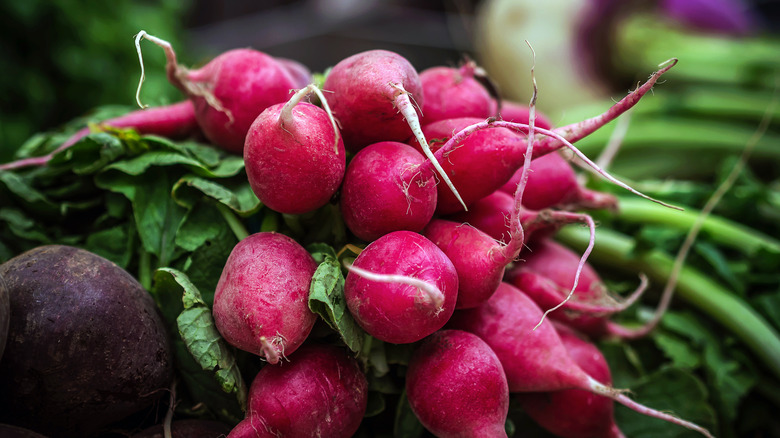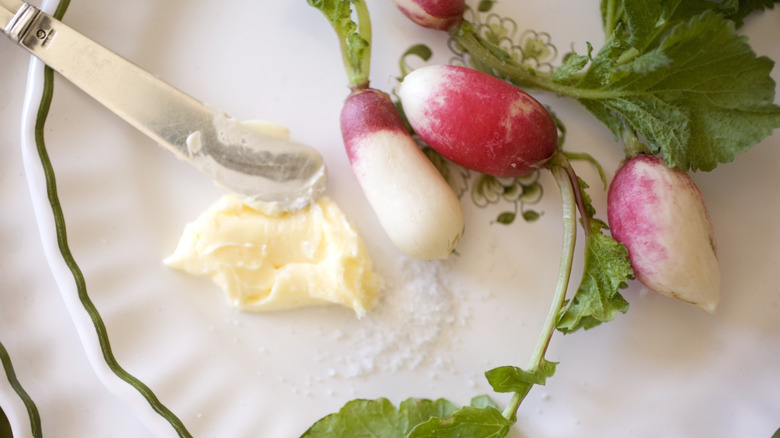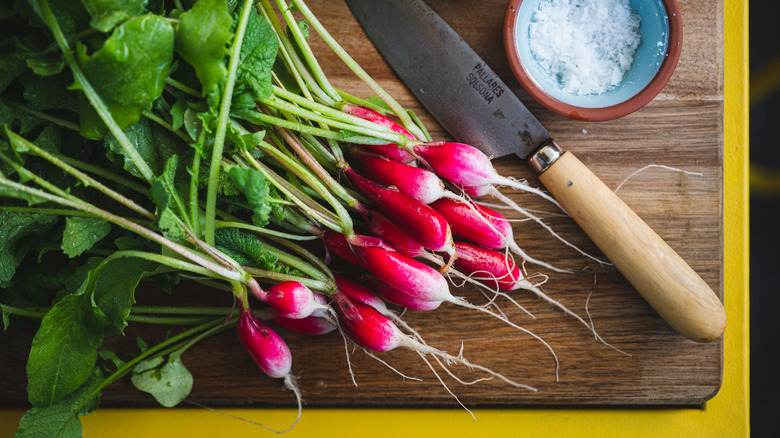We Can't Stop Eating Radishes The French Way. Here's What That Means
There are a great number of beautiful French dishes that take ages to make. Luxurious recipes like cassoulet or fresh-baked croissants require hours of hands-on work or days of resting before you can dine — demanding a level of devotion that often lends a reputation of decadence. But if there's one thing French chefs can do, it's keeping their sophistication simple. On the opposite end of France's culinary complication spectrum, you'll find just as much richness. Take, for example, the French way of consuming radishes with butter.
This dish is nearly as simple as its moniker (the third ingredient of salt didn't make the title, but we'll get to that in a minute). There's a reason that the radish-and-butter popularity has endured. Practically no recipe is needed to get the bright flavor of this mix on your plate — just three fresh and high-quality ingredients. So gather your radishes, butter, and salt, because it's time to get to the kitchen and make this dish.
A little butter will mellow the bite
In its purest form, radishes eaten the French way only ask you to spread some butter on fresh, raw radishes, then sprinkle them with salt. The traditional method leaves a small piece of the radish stem intact so that you can hold onto it while you snack. To allow for easier eating, you can cut the radishes in half or slice them before sprinkling with salt, spreading butter, and then salting the butter. The double salting isn't required, but it does enhance the radish's flavor.
Even if you aren't normally a radish fan, this uncomplicated combination is worth trying. Raw radishes typically have a bold, peppery, and occasionally spicy character that can sometimes overwhelm your palate with its very pronounced bite. That's where the butter comes in. A rich but mild butter can calm the radish and make its strong flavor far more palatable.
As with any minimal recipe, quality is crucial, so take time to understand the many types of butter you'll encounter. Here, you should use a rich European-style butter that's at least 82% butterfat (making it richer than many U.S. butters). Your radishes should have vibrant green tops and a firm texture to indicate freshness. Among the many radish varieties you should know, keep French radishes on your radar (sometimes called French breakfast radishes). These have an oval shape and a more mild taste that works well in this simple dish.
If you're feeling salty, try a sprinkle of fleur de sel
With the golden glow of European butter and the alluring pink hue of fresh radishes, the salt can often take a backseat when you're assembling radishes the French way. But there's a right answer for salt, too (or at least a suggested answer). When researching, you might come across a casual mention of fleur de sel, but this ingredient is far from casual. Unless you do your shopping in higher-end grocery stores or specialty markets, this French sea salt likely won't be just sitting on the shelves. What's more, it can get pricey.
But its flavor is more than just merely salty and helps it stand out amongst the many other types of salt out there. Fleur de sel is harvested by hand from pools of seawater on coast of France. Its delicate flakes bring a bright, even sweet quality to a dish. Because of its expense, as well as a higher moisture content that gives it more potency, fleur de sel is typically used at the end of cooking rather than throughout the process. Since salt gets to be front and center in this French-style radish snack, this flaky ingredient is a luxurious finishing salt that's well worth seeking out.


